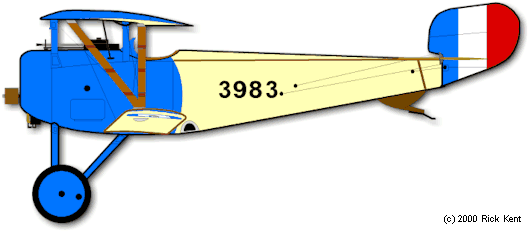Nieuport 28
%2001.jpg)
The Nieuport 28 C.1, a French biplane fighter aircraft flown during World War I, was built by Nieuport and designed by Gustave Delage. Owing its lineage to the successful line of sesquiplane fighters that included the Nieuport 17, the Nieuport 28 continued a similar design philosophy of a lightweight and highly maneuverable aircraft.
By the time the Nieuport 28 was available, the SPAD XIII had been chosen to equip the escadrilles de chasse of the Aéronautique Militaire for 1918, and this fighter was also the first choice for the projected American "pursuit" squadrons.[2] In the event, a shortage of SPADs led to Nieuport 28s being issued to four American squadrons between March and August 1918, becoming the first aircraft to see operational service with an American fighter squadron.
Nieuport 28s saw considerable post-war service: in particular 50 were "returned" to America, and as well as army and naval service these found civilian use, especially in Hollywood films.
https://en.wikipedia.org/wiki/Nieuport_28Nieuport 27

The Nieuport 27 (or Nieuport XXVII C.1 in contemporary sources) was a World War I French sesquiplane fighter aircraft designed by Gustave Delage. The 27 was the last of the line of Nieuport "V-strut" single seat fighters that began with the Nieuport 10 of 1914. Operational examples supplemented the very similar Nieuport 24 and 24bis in operational squadrons in late 1917 and many would also be used as advanced trainers.
https://en.wikipedia.org/wiki/Nieuport_27Nieuport 17 & 24

The Nieuport 24 (or Nieuport XXIV C.1 in contemporary sources) was a World War I French sesquiplane fighter aircraft designed by Gustave Delage as a development of the successful Nieuport 17.
The Nieuport 24 had the misfortune to be the penultimate design suited to tactics that were being superseded when it entered service. Its small size, relatively light weight and small engine gave it a significant manoeuvrability advantage in a dog fight; however, larger and heavier fighters that relied almost entirely on speed such as the SPAD VII and Albatros D.III were entering service along with the introduction of ever larger combat formations, which generally negated its manoeuvrability. While its handling was improved slightly, its performance was little better than the previous Nieuport 23 it was meant to replace, and so it was operated alongside larger numbers of the SPAD S.VII, although in November 1917, out of a French frontline fighter strength of 754 aircraft, Nieuports still made up 310 aircraft.[1] Operational Nieuport 24s served with French, British and Russian units, and the type also served widely as an advanced trainer.
https://en.wikipedia.org/wiki/Nieuport_24The Nieuport 17 C.1 (or Nieuport XVII C.1 in contemporary sources) was a French sesquiplane fighter designed and manufactured by the Nieuport company during World War I. An improvement over the Nieuport 11, it was a little larger than earlier Nieuports and better adapted to the more powerful engine than the interim Nieuport 16. Aside from early examples, it had the new Alkan-Hamy synchronization gear, permitting the use of a fuselage-mounted synchronised Vickers gun firing through the propeller disc.
At the time of its introduction in March 1916, the type's outstanding manoeuvrability and excellent rate of climb gave it a significant advantage over fighters on both sides and was described as "the best pursuit plane of the day".[1][2] It was used by many operators and entered service with every Allied power and copies were also operated by the Deutsche Luftstreitkräfte (German Air Service). Mass-produced by several French firms, the Nieuport 17 and its derivatives were built under licence in Italy by Nieuport-Macchi and in Russia by Dux. Unlicenced copies, notably the Siemens-Schuckert D.I and the Euler D.I, were produced in Germany.
https://en.wikipedia.org/wiki/Nieuport_17Nieport 16

The Nieuport 16 C.1 (or Nieuport XVI C.1 in contemporary sources)[note 1] was a French World War I single-seat sesquiplane fighter aircraft, designed by Gustave Delage as a development of the Nieuport 11 with a more powerful engine. The Nieuport 16's service life coincided with the period when the first air-to-air rockets, the Le Prieur rocket, were used most frequently, and the type has a closer association with them than any other aircraft.
https://en.wikipedia.org/wiki/Nieuport_16